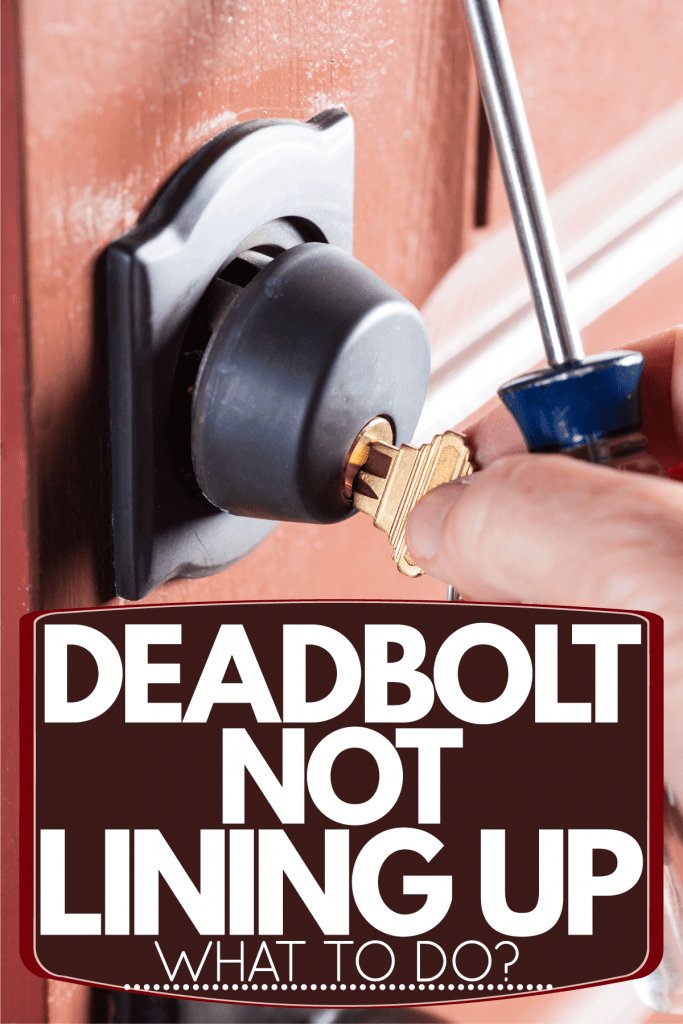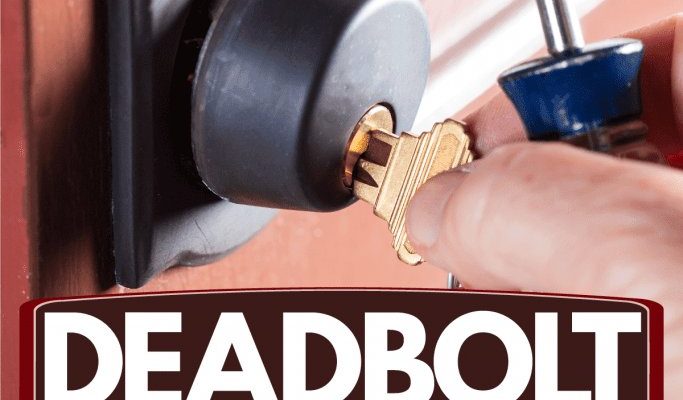
If you have a name-brand deadbolt like Schlage, Kwikset, or Yale, most of these issues are due to similar causes. Deadbolts are pretty simple—no fancy code or electronics unless you have a smart lock—but even the best brands can get finicky over time. Dust, misalignment, or even changes in humidity can throw things off. Here’s the thing: you don’t need to be a locksmith to get your deadbolt clicking confidently again. Let’s walk through what’s going on, what you can do about it, and a few easy steps to make sure you’re locking up with confidence.
Why Your Deadbolt Isn’t Clicking Firmly Into Place
When a deadbolt doesn’t click into place, something’s usually blocking the bolt or the lock isn’t lined up right. Sometimes, it’s mechanical wear—other times, it’s just that your door frame or strike plate has shifted a bit. Weather can even swell your door, making everything fit just a bit tighter or looser. Most of us notice this when it gets humid or after a big temperature swing.
Honestly, a firm *click* is more than just a sound. It’s the physical sign your deadbolt is fully extended, sitting in its metal strike plate. If you’re not getting that feedback, the bolt might not be sitting in the hole all the way, or the lock mechanism might not be reaching its full locking position. Think of it like putting a plug into an outlet—you want it tight and secure, not half-hanging out.
Mechanical deadbolts (the kind you turn with a key or thumbturn) rely on everything lining up perfectly. If your lock worked fine for years and suddenly stopped clicking, something probably shifted. Door settling, loose screws, or gunk inside the lock can all be suspects. For smart or electronic deadbolts, a weak battery or motor misfire can cause similar problems, but this article will stick to standard deadbolts for simplicity.
How A Deadbolt Works: The Basics Behind the Click
Let me explain how these locks are supposed to work. When you turn your key or thumbturn, you’re moving a metal bolt from the door into a hole in your door frame. That hole is reinforced with a metal plate, called the strike plate, and it needs to line up perfectly with the bolt for everything to click into place. The click itself comes from a spring or latch engaging as the bolt reaches its end position.
Why does this matter? If the strike plate is misaligned—even by a millimeter—the bolt can hit the edge of the metal or wood and stop short. No click, no firm lock. Sometimes, the hole behind the strike plate isn’t deep enough, or it has debris inside, blocking the bolt. Or, if the door has sagged or the hinges are loose, the entire lock can be out of sync with the frame.
A lot of people assume their lock is broken when this happens, but more often, it’s the door or frame that’s out of whack. It’s a bit like trying to plug a charger into your phone when the port is dirty or bent: you can push, but it doesn’t seat properly. And without a solid click, you can never be sure it’s really connected.
Checking for Mechanical Obstructions and Alignment Issues
The first thing to check is whether the bolt is actually making it into the hole—and if the hole lines up with the deadbolt. Here’s what to do:
- Open the door and turn the deadbolt. It should slide in and out smoothly, clicking into place when fully extended. If it sticks or doesn’t reach all the way, the problem is inside the lock, not the door frame.
- Close the door and try the bolt again. If it now feels stiff or the click is missing, the bolt is probably hitting the edge of the strike plate or frame instead of its hole.
- Look for marks on the strike plate and bolt. Scratches or metal shavings show where things are rubbing or catching.
- Check the hole’s depth behind the strike plate. Sometimes, wood chips, old paint, or even sawdust can build up there, blocking the bolt. Use a flashlight and a screwdriver to clear it out if needed.
If any part of the bolt or strike plate looks bent, warped, or loose, tighten it up with a screwdriver. Even a tiny wobble in the strike plate can throw things out of sync. When checking alignment, remember that even a small shift in door position can break that satisfying click. Hinges, weatherstripping, or a swollen door might be pushing things just a bit too tight.
The quickest way to diagnose a click issue is to test the deadbolt with the door open. If it works fine this way, your problem is all about alignment—not the lock itself.
Fixing a Misaligned Strike Plate or Frame
If your deadbolt clicks just fine with the door open but struggles when the door is closed, you’re dealing with a strike plate or frame problem. Here’s how you can handle it—even if you’ve never done a door repair before:
- Loosen the strike plate screws just a little. See if you can nudge the plate up, down, or sideways so the bolt lines up better. Sometimes a few millimeters of movement is all you need.
- Test the deadbolt after every tiny adjustment. Close the door, try the lock, and look for that firm click. If it’s still sticky, adjust again.
- If the hole behind the strike plate isn’t deep enough, drill out the hole a bit more. Use a drill bit or chisel to clear any debris or make the hole just a bit deeper. Don’t go wild—just enough so the bolt can slide freely.
- If your door sags, tighten or replace the hinge screws. Sometimes, just tightening up the top hinge will lift your door enough to bring things back into sync.
You might be wondering, “Do I really need to mess with drilling and screws?” Honestly, yes—at least a little. Most deadbolt problems are solved by simple, small adjustments to the plate or door frame. You don’t need to be a carpenter—just patient.
Cleaning and Lubricating the Deadbolt Mechanism
Sometimes, the reason your deadbolt won’t click into place firmly has nothing to do with alignment, but with dirt, grime, or lack of lubrication inside the lock. If your lock feels gritty, squeaky, or sticks even with the door wide open, it probably needs a quick clean and lube.
Here’s how you can do it safely:
- Remove the deadbolt from the door (usually a couple of screws on the inside plate).
- Inspect for debris: Look for dust, cobwebs, or any obvious gunk. Use a can of compressed air to blow out any particles, or a small brush for stubborn spots.
- Lubricate the bolt and moving parts with a graphite-based lock lubricant. Don’t use WD-40 or regular oil—they attract dust and can gum up the lock over time.
- Reinstall and test: Put the deadbolt back and test it several times (both with the door open and closed) to check for improvement.
If the lock still won’t click into position, the internal mechanism might be worn out. Over time, springs and small parts inside the deadbolt can break or loosen. In that case, you might need a replacement. But in most cases, a good clean and a bit of lock lube will have everything gliding—and clicking—like new.
What If the Deadbolt Still Won’t Click?
Let’s say you’ve checked alignment, cleaned the lock, adjusted the strike plate, and you’re *still* not getting that click. What’s next? Sometimes, the deadbolt itself is the issue. Springs inside can wear down, or the bolt can get bent slightly from years of use.
If the mechanism feels loose, rattly, or makes a grinding noise, it’s a good sign the internal parts are worn. In this case, replacing the deadbolt is usually faster (and more secure) than trying to repair it. Most popular brands—like Schlage and Kwikset—offer straightforward replacement kits at any hardware store.
Here’s the cool part: modern deadbolts are designed for easy installation. Just take out the old one, match the new one to your door’s thickness, and screw it in. You won’t need to code, reset, or sync anything unless you’re upgrading to a smart lock.
If you rent and can’t replace the lock yourself, talk to your landlord or property manager. A deadbolt that doesn’t lock firmly is a safety and liability issue, and it’s their job to keep things secure.
Comparing Deadbolt Types: Standard vs Smart Locks
You might be wondering if a smart deadbolt has different issues when it refuses to click into place. Here’s the short answer: mechanical problems are mostly the same. The main difference is that smart locks add electronic parts—like a motor and battery—that can introduce new troubleshooting steps.
With a classic deadbolt, everything relies on physical movement. With a smart deadbolt (think August, Schlage Encode, or Yale Assure), the motor replaces your hand to move the bolt. If the batteries are low or the motor is weak, the bolt can stop short before it “clicks” fully into the strike plate.
But the solutions are pretty similar:
- Check and replace the batteries if you notice hesitation or the bolt doesn’t travel all the way.
- Reset or re-sync the lock if the bolt is stalling in the same spot every time.
- Double-check the mechanical alignment—even a smart lock can’t overcome a misaligned strike plate or a blocked bolt hole.
Here’s the thing: whether you’re using a standard or smart deadbolt, the feel of the lock *clicking* firmly in place is your best signal that things are lined up, secure, and good to go.
When To Call a Locksmith (And Why You Might Not Need One)
Most deadbolt issues are totally DIY-friendly, but sometimes bringing in a locksmith is the smarter move. If you’ve tried all the steps above, and you still don’t get a firm click (or if something feels stuck or unsafe), it might be a sign of deeper trouble.
Locksmiths have special tools and know-how—they can realign bent frames, repair internal lock parts, and rekey or replace your lock if necessary. But don’t feel like you have to jump to this step. Plenty of homeowners solve deadbolt problems with just a screwdriver and a bit of patience.
If your lock is under warranty, don’t attempt a full disassembly or force anything—call the manufacturer or your locksmith first. For rental properties, always let your landlord know what’s going on before making changes. A non-clicking deadbolt is more than an annoyance; it’s a safety risk, and it’s reasonable to expect a quick fix.
In most cases, fixing a deadbolt that doesn’t click firmly into place is a minor home repair—more about attention to detail than brute strength or expertise.
Wrapping Up: Enjoying a Confident Lock Once Again
Few things are more satisfying than that *click* when you lock your door, knowing it’s secure. If your deadbolt doesn’t click into place firmly, the problem is usually small: a bit of dirt, a shifted plate, a loose screw, or a door that’s drifted out of alignment. Sometimes, it’s a tired bolt or spring inside the lock itself. Whether you have a classic Schlage or Kwikset, or a newer smart lock, the steps above should help you get that secure, reassuring snap—without calling in the pros.
Remember: test your deadbolt with the door open first, check for simple alignment issues, clean and lubricate the mechanism, and make adjustments as needed. Don’t be afraid to tweak, tighten, or even upgrade to a new lock if yours is truly worn out. With a bit of patience, your deadbolt will be back to smooth, confident locking—no more wimpy, uncertain clicks. Safe (and satisfying) locking!
